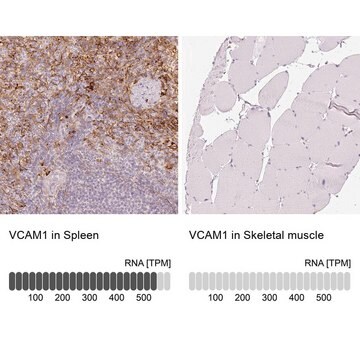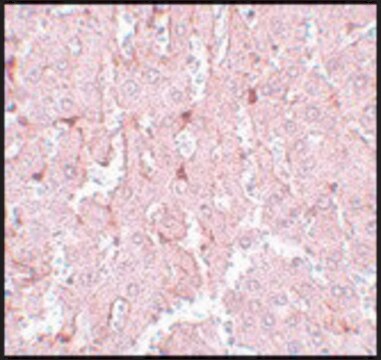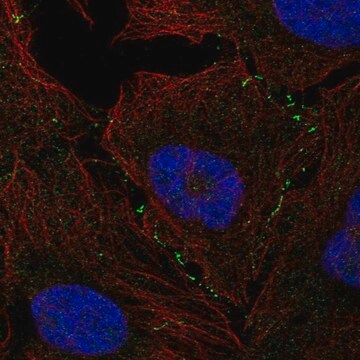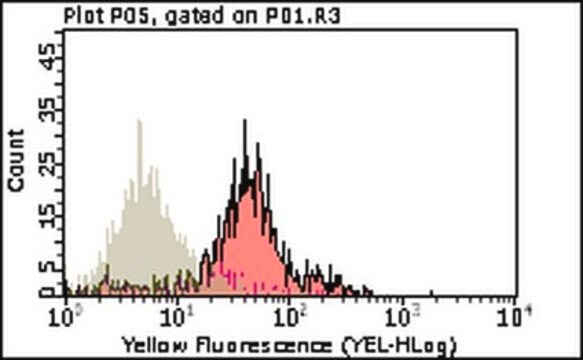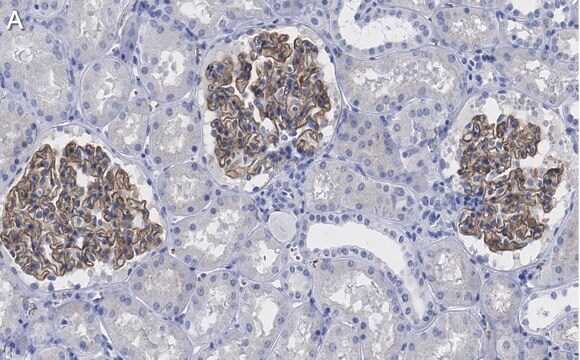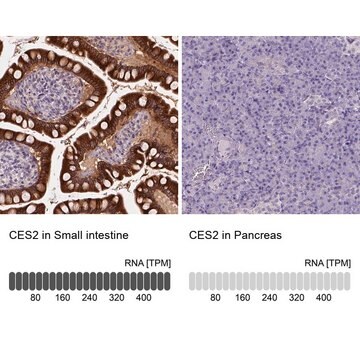SAB1402959
Monoclonal Anti-VCAM1 antibody produced in mouse
clone 1H6, purified immunoglobulin, buffered aqueous solution
Synonyme(s) :
CD106, DKFZp779G2333, INCAM-100, MGC99561
About This Item
Produits recommandés
Source biologique
mouse
Niveau de qualité
Conjugué
unconjugated
Forme d'anticorps
purified immunoglobulin
Type de produit anticorps
primary antibodies
Clone
1H6, monoclonal
Forme
buffered aqueous solution
Poids mol.
antigen ~107.4 kDa
Espèces réactives
human
Technique(s)
capture ELISA: suitable
indirect ELISA: suitable
western blot: 1-5 μg/mL
1 of 4
Cet article | EHU066841 | EHU034711 | EHU091521 |
|---|---|---|---|
| product line MISSION® | product line MISSION® | product line MISSION® | product line MISSION® |
| esiRNA cDNA target sequence CCTTGAACGCAAAGTGGAATCTTTGCAAGAAGAGATTGCCTTTTTGAAGAAACTCCACGAAGAGGAAATCCAGGAGCTGCAGGCTCAGATTCAGGAACAGCATGTCCAAATCGATGTGGATGTTTCCAAGCCTGACCTCACGGCTGCCCTGCGTGACGTACGTCAGCAATATGAAAGTGTGGCTGCCAAGAACCTGCAGGAGGCAGAAGAATGGTACAAATCCAAGTTTGCTGACCTCTCTGAGGCTGCCAACCGGAACAATGACGCCCTGCGCCAGGCAAAGCAGGAGTCCACTGAGTACCGGAGACAGGTGCAGTCCCTCACCTGTGAAGTGGATGCCCTTAAAGGAACCAATGAGTCCCTGGAACGCCAGATGCGTGAAATGGAAGAGAACTTTGCCGTTGAAGC | esiRNA cDNA target sequence CCCTCAGATCCCAGTTCCTTTAGAAAGCAGTTACCCAACAGAAACATTCTGGGCTGGGAACCAGGGAGGCGCCCTGGTTTGTTTTCCCCAGTTGTAATAGTGCCAAGCAGGCCTGATTCTCGCGATTATTCTCGAATCACCTCCTGTGTTGTGCTGGGAGCAGGACTGATTGAATTACGGAAAATGCCTGTAAAGTCTGAGTAAGAAACTTCATGCTGGCCTGTGTGATACAAGAGTCAGCATCATTAAAGGAAACGTGGCAGGACTTCCATCTGTGCCATACTTGTTCTGTATTCGAAATGAGCTCAAATTGATTTTTTAATTTCTATGAAGGATCCATCTTTGTATATTTACATGCTTAGAGGGGTGAAAATTATTTTGGAAATTGAGTCTGAAGCACTCTCGCACACACAG | esiRNA cDNA target sequence AAGGACAGTTGTGGCAAAGGAGAAATGGCCACAGGGAATGGGCGGCGGCTCCACCTGGGGATTCCTGAGGCCGTGTTTGTGGAAGATGTAGATTCCTTCATGAAACAGCCTGGGAATGAGACTGCAGATACAGTATTAAAGAAGCTGGATGAACAGTACCAGAAGTATAAGTTTATGGAACTCAACCTTGCTCAAAAGAAAAGAAGGCTAAAAGGTCAGATTCCTGAAATTAAACAGACTTTGGAAATTCTAAAATACATGCAGAAGAAAAAAGAGTCCACCAACTCAATGGAGACCAGATTCTTGCTGGCAGATAACCTGTATTGCAAAGCTTCAGTTCCTCCTACCGATAAAATGTGTCTGTGGTTGGGGGCTAATGTAATGCTTGAATATGATATTGATGAAGCTCAGGCATTGTTGGAAAAGAATTTATCGACTGCCACAAAGAATCTTGATTCCCTGGAGGAAGACCT | esiRNA cDNA target sequence TCCAGGAATCTGCAGTCAAATTTGTATCAACTTAAAAGGCGGTTACAAGTGTGAATGTAGTCGTGGCTATCAAATGGATCTTGCTACTGGCGTGTGCAAGGCAGTAGGCAAAGAGCCAAGTCTGATCTTCACTAATCGAAGAGACATCAGGAAGATTGGCTTAGAGAGGAAAGAATATATCCAACTAGTTGAACAGCTAAGAAACACTGTGGCTCTCGATGCTGACATTGCTGCCCAGAAACTATTCTGGGCCGATCTAAGCCAAAAGGCTATCTTCAGTGCCTCAATTGATGACAAGGTTGGTAGACATGTTAAAATGATCGACAATGTCTATAATCCTGCAGCCATTGCTGTTGATTGGGTGTACAAGACCATCTACTGGACTGATGCGGCTTCTAAG |
| Ensembl | human accession no. | Ensembl | human accession no. | Ensembl | human accession no. | Ensembl | human accession no. |
| NCBI accession no. | NCBI accession no. | NCBI accession no. | NCBI accession no. |
| storage temp. −20°C | storage temp. −20°C | storage temp. −20°C | storage temp. −20°C |
Description générale
Immunogène
Sequence
MPGKMVVILGASNILWIMFAASQAFKIETTPESRYLAQIGDSVSLTCSTTGCESPFFSWRTQIDSPLNGKVTNEGTTSTLTMNPVSFGNEHSYLCTATCESRKLEKGIQVEIYSFPKDPEIHLSGPLEAGKPITVKCSVADVYPFDRLEIDLLKGDHLMKSQEFLEDADRKSLETKSLEVTFTPVIEDIGKVLVCRAKLHIDEMDSVPTVRQAVKELQVYISPKNTVISVNPSTKLQEGGSVTMTCSSEGLPAPEIFWSKKLDNGNLQHLSGNATLTLIAMRMEDSGIYVCEGVNLIGKNRKEVELIVQEKPFTVEISPGPRIAAQIGDSVMLTCSVMGCESPSFSWRTQIDSPLSGKVRSEGTNSTLTLSPVSFENEHSYLCTVTCGHKKLEKGIQVELYSFPRDPEIEMSGGLVNGSSVTVSCKVPSVYPLDRLEIELLKGETILENIEFLEDTDMKSLENKSLEMTFIPTIEDTGKALVCQAKLHIDDMEFEPKQRQSTQTLYVNVAPRDTTVLVSPSSILEEGSSVNMTCLSQGFPAPKILWSRQLPNGELQPLSENATLTLISTKMEDSGVYLCEGINQAGRSRKEVELIIQVTPKDIKLTAFPSESVKEGDTVIISCTCGNVPETWIILKKKAETGDTVLKSIDGAYTIRKAQLKDAGVYECESKNKVGSQLRSLTLDVQGRENNKDYFSPELLVLYFASSLIIPAIGMIIYFARKANMKGSYSLVEAQKSKV
Actions biochimiques/physiologiques
Forme physique
Clause de non-responsabilité
Vous ne trouvez pas le bon produit ?
Essayez notre Outil de sélection de produits.
En option
Code de la classe de stockage
10 - Combustible liquids
Classe de danger pour l'eau (WGK)
WGK 1
Point d'éclair (°F)
Not applicable
Point d'éclair (°C)
Not applicable
Faites votre choix parmi les versions les plus récentes :
Certificats d'analyse (COA)
Vous ne trouvez pas la bonne version ?
Si vous avez besoin d'une version particulière, vous pouvez rechercher un certificat spécifique par le numéro de lot.
Déjà en possession de ce produit ?
Retrouvez la documentation relative aux produits que vous avez récemment achetés dans la Bibliothèque de documents.
Disease and Treatment Outcome
Notre équipe de scientifiques dispose d'une expérience dans tous les secteurs de la recherche, notamment en sciences de la vie, science des matériaux, synthèse chimique, chromatographie, analyse et dans de nombreux autres domaines..
Contacter notre Service technique